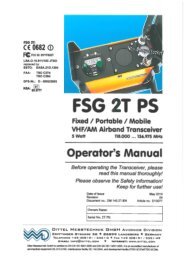EFIS-D6 Installation Guide
EFIS-D6 Installation Guide
EFIS-D6 Installation Guide
You also want an ePaper? Increase the reach of your titles
YUMPU automatically turns print PDFs into web optimized ePapers that Google loves.
Instrument <strong>Installation</strong><br />
D10A is aligned with the <strong>EFIS</strong>-<strong>D6</strong> to better than 1 degree.<br />
• All mounting hardware needs to be made from non-ferrous material such as aluminum,<br />
plastic, or brass. Many stainless steel screws are magnetic. If the item is attracted to a<br />
magnet, it should not be used in the installation. The EDC-D10A needs to be mounted in a<br />
location as free from magnetic interference as possible. This means keeping the EDC-D10A<br />
away from any ferrous nuts, bolts, and screws, aircraft tubing, as well as from wires or<br />
devices carrying any appreciable current such as strobe light wiring, autopilot servos, or<br />
other electronics.<br />
EDC-D10A Communication Cable<br />
DO NOT ATTEMPT TO POWER UP THE <strong>EFIS</strong>-<strong>D6</strong> WITH THE EDC CABLE LEADS<br />
EXPOSED (UNSHEATHED) AND NOT INSTALLED IN THE DB9 CONNECTOR.<br />
SHORTING THESE CONNECTIONS WILL CAUSE DAMAGE TO THE UNIT.<br />
Like the RS-232 PC Communication cable, the EDC-D10A communications cable terminates in<br />
a standard female DB9 connector. While they look similar, do not plug the EDC cable into a PC<br />
or vice versa. The following table outlines the four connections that must be made to ensure<br />
proper communication between the <strong>EFIS</strong>-<strong>D6</strong> and the EDC-D10A remote compass module. The<br />
Dynon-supplied harness colors are listed, as well.<br />
<strong>EFIS</strong><br />
DB25 pin#<br />
EDC<br />
DB9 pin# Function Wire color<br />
11 5 EDC Data B White/Orange (or Red)<br />
12 6 EDC Power White/Blue (or Black)<br />
23 9 EDC Data A White/Green (or Green)<br />
24 1 EDC Ground White<br />
The EDC cable in the harness supplied by Dynon consists of 4 conductors, surrounded by a<br />
metal shield and white insulation. These 4 wires are terminated with crimped female D-sub pins<br />
wrapped in plastic tubing. If you are building your own cable, we recommend that you use<br />
shielded cable as well.<br />
• With the 25-pin <strong>EFIS</strong> harness disconnected from the <strong>EFIS</strong>-<strong>D6</strong>, carefully cut or pull the<br />
tubing off the 4 D-sub pins.<br />
• Route the cable to the EDC-D10A mounting location chosen according to the instructions<br />
above.<br />
• Install the female pins in the correct holes on the included DB9 connector, according to the<br />
chart above.<br />
• Install the back shell around the DB9 connector.<br />
Correct wiring installation can be easily verified once completed. Power on the <strong>EFIS</strong>-<strong>D6</strong> with<br />
the EDC-D10A connected to it. If you have correctly wired your EDC-D10A wiring harness you<br />
will see the heading properly displayed at the top of the screen (provided you have turned on the<br />
heading display in the CLUTTR menu). If wiring is not correct, or the EDC-D10A is not<br />
communicating properly with the <strong>EFIS</strong>-<strong>D6</strong>, you will see the message REMOTE COMPASS<br />
NOT DETECTED in place of the heading onscreen.<br />
3-2 <strong>EFIS</strong>-<strong>D6</strong> <strong>Installation</strong> <strong>Guide</strong>
















